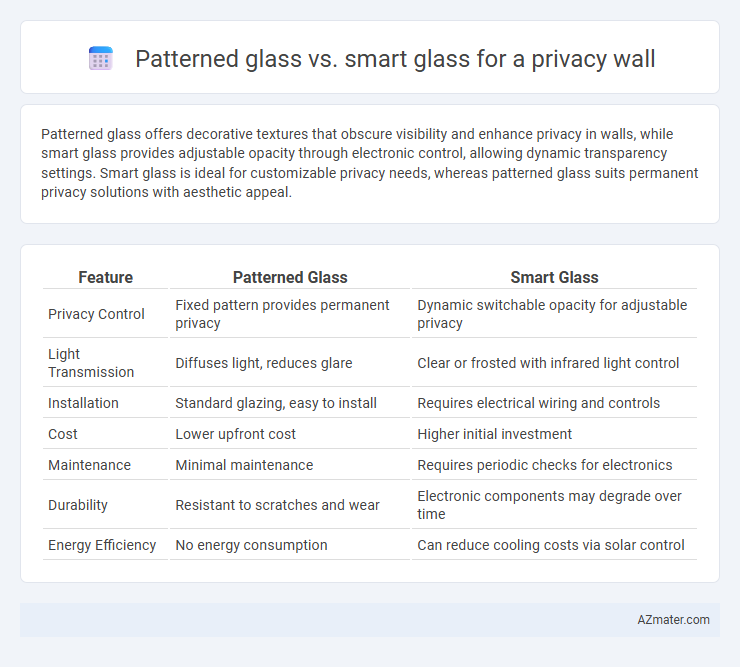Patterned glass offers decorative textures that obscure visibility and enhance privacy in walls, while smart glass provides adjustable opacity through electronic control, allowing dynamic transparency settings. Smart glass is ideal for customizable privacy needs, whereas patterned glass suits permanent privacy solutions with aesthetic appeal.
Table of Comparison
| Feature | Patterned Glass | Smart Glass |
|---|---|---|
| Privacy Control | Fixed pattern provides permanent privacy | Dynamic switchable opacity for adjustable privacy |
| Light Transmission | Diffuses light, reduces glare | Clear or frosted with infrared light control |
| Installation | Standard glazing, easy to install | Requires electrical wiring and controls |
| Cost | Lower upfront cost | Higher initial investment |
| Maintenance | Minimal maintenance | Requires periodic checks for electronics |
| Durability | Resistant to scratches and wear | Electronic components may degrade over time |
| Energy Efficiency | No energy consumption | Can reduce cooling costs via solar control |
Introduction to Privacy Wall Solutions
Patterned glass provides a cost-effective Privacy wall solution by using textured designs to obscure visibility while allowing natural light to pass through. Smart glass technology enhances privacy with electronically controlled opacity, enabling instant transition between transparent and frosted states. Both options offer unique benefits, with patterned glass emphasizing aesthetics and smart glass prioritizing dynamic functionality for modern privacy needs.
What is Patterned Glass?
Patterned glass is a type of textured glass featuring various designs, such as rain, reed, or hammered patterns, which obscure visibility while allowing natural light to pass through. It is commonly used in privacy walls to create a decorative yet functional barrier that enhances privacy without compromising brightness. Unlike smart glass, patterned glass does not require electrical power or control mechanisms, making it a cost-effective and low-maintenance option for privacy solutions.
What is Smart Glass?
Smart glass, also known as switchable glass, utilizes electrochromic or liquid crystal technology to change from transparent to opaque with the flip of a switch, providing instant privacy without compromising natural light. Patterned glass, on the other hand, features decorative textures or frosted designs permanently embedded into the glass, offering consistent but static privacy. Smart glass is ideal for dynamic privacy control in office partitions, conference rooms, and residential privacy walls where versatility and modern aesthetics are crucial.
Visual Privacy: Patterned Glass vs Smart Glass
Patterned glass offers consistent visual privacy by distorting shapes and blurring outlines, making it ideal for areas requiring moderate obscurity without electronic components. Smart glass enhances privacy dynamically by switching from transparent to opaque states through electrical control, providing flexibility for spaces needing adjustable visibility. While patterned glass relies on physical texture for permanent privacy, smart glass delivers advanced functionality with higher cost and power dependency.
Light Transmission and Aesthetics
Patterned glass offers varying degrees of light transmission depending on its texture, creating a diffused glow that maintains privacy while adding decorative appeal. Smart glass provides adjustable opacity, enabling users to control light transmission from clear to fully frosted, enhancing privacy on demand with a sleek, modern aesthetic. Both materials blend functionality with style, but smart glass delivers dynamic light management, whereas patterned glass offers consistent, artistic diffusion.
Technology and Functionality Comparison
Patterned glass utilizes traditional etching or rolling techniques to create fixed decorative textures that distort visibility while allowing light transmission, offering constant privacy without electronic components. Smart glass employs electrochromic, liquid crystal, or suspended particle technologies to dynamically switch between transparent and opaque states, providing adjustable privacy controlled via electrical signals or sensors. The functionality of smart glass extends beyond static privacy walls by enabling remote operation, energy efficiency through light modulation, and integration with smart building systems, whereas patterned glass prioritizes durability and simplicity without requiring power.
Installation and Maintenance Requirements
Patterned glass installation requires standard glazing processes and minimal technical expertise, making it straightforward and cost-effective for privacy walls. Smart glass installation involves integrating electrical components, necessitating specialized wiring and professional setup to ensure functionality and safety. Maintenance for patterned glass is low, typically limited to regular cleaning, while smart glass demands periodic electrical inspections and potential software updates to maintain optimal performance.
Cost Analysis: Patterned Glass vs Smart Glass
Patterned glass typically costs between $15 to $40 per square foot due to its simpler manufacturing process and wide availability, making it a budget-friendly option for privacy walls. Smart glass, using advanced technologies like electrochromic or thermochromic films, ranges from $50 to $150 per square foot, reflecting higher material and installation expenses. Maintenance costs for smart glass can also be higher, factoring in electronic controls and potential repairs, whereas patterned glass remains low-maintenance and durable over time.
Energy Efficiency and Sustainability
Patterned glass provides basic privacy while allowing natural light, but its energy efficiency is limited compared to smart glass, which dynamically controls light transmission to reduce heat gain and loss. Smart glass enhances sustainability by lowering HVAC energy consumption and minimizing the need for artificial lighting through adaptive tinting. Both options contribute to privacy, yet smart glass offers superior performance in energy conservation and environmental impact.
Best Applications for Patterned and Smart Glass
Patterned glass is ideal for privacy walls in commercial offices, conference rooms, and bathrooms due to its textured surface that diffuses light while obscuring visibility. Smart glass is best suited for high-tech environments such as executive suites, healthcare facilities, and modern homes where instant switchable privacy is essential. Both types enhance aesthetic appeal but patterned glass offers permanent privacy while smart glass provides dynamic control over transparency.

Infographic: Patterned glass vs Smart glass for Privacy wall
 azmater.com
azmater.com